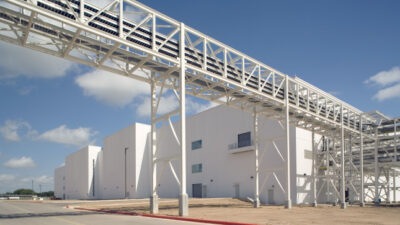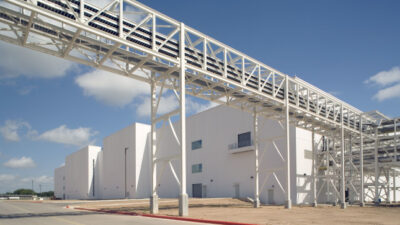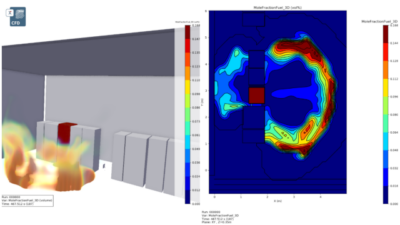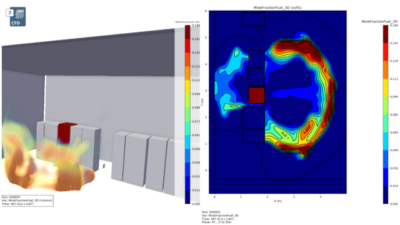While engineers and contractors have traditionally pieced together a facility's electrical system utilizing equipment from different manufacturers, in some cases, the option of choosing pre-integrated systems has become a possibility—for example, gensets, switchgear and controls all in one package.
While engineers and contractors have traditionally pieced together a facility’s electrical system utilizing equipment from different manufacturers, in some cases, the option of choosing pre-integrated systems has become a possibility—for example, gensets, switchgear and controls all in one package.
However, both manufacturers and engineers claim that such pre-assembled systems only make sense with certain applications. And while some say that this approach can cut down on troubleshooting efforts and costs in the long run, others are not so optimistic that the economics make sense for the vast majority of projects.
Taking a Closer Look
For example, Rick Allison, an engineering manager with Enercon Engineering, E. Peoria, Ill., notes that his company offers the option of building controls switchgear into its gensets at the factory. But practically speaking, only 5% to 10% of systems are actually pre-assembled in this manner.
The main reason, says Allison, is that these systems often require a certain level of customization for each individual application, particularly when it comes to connecting to the local utility. Allison has also found big differences among consulting engineers as to how they write specifications in the arena of protection and controls.
“There are such large variances between how controls packages are specified and between utility intertie requirements that it becomes difficult to provide a one-size-fits-all, standard product,” says Allison. However, in the minority of cases when his company does this kind of pre-integrated packaging, they often work with Caterpillar, Waukesha and Cummins, among other genset manufacturers.
Similarly, Dan Sylvester, director of marketing for ASCO Power Technologies’ Anaheim, Calif. office, states that simply integrating a genset into a facility’s building load requires quite a bit of customization.
Consequently, the only market sectors where his company has been involved in pre-packaging its switchgear with UPS units from manufacturers such as Liebert has been for financial and telecom facilities.
“With these applications, the cookie-cutter repeat approach makes sense because the end-user wants standardization of product at different sites,” he says.
As a side note, Sylvester adds that with the rapid slowdown of the telecom market, there is currently less of a demand for this kind of pre-integrated product.
Integrating Cogen
One area where pre-integrated systems are more commonly found is cogeneration applications. In these cases, consulting engineers who specify cogen, like Randy Minnier, P.E., principal of MPE Consulting, San Diego, can find pre-packaged cogen systems with controls, interconnection switchgear and integrated relay protection. Additional pre-integrated options include TVSS devices and metering equipment.
“We’ve put cogen into 20 high-rise buildings in California and still have 40 to go,” says Minnier, noting that the state’s utility rate structure’s deferment of departing load charges until December of 2004 has created somewhat of a cogen boom in the state.
While Minnier’s firm has worked quite a bit with Encorp and Cutler-Hammer, he says that they are very open to looking at other manufacturers. Consequently, when evaluating integrated options, Minnier says, his engineers look at pricing and at who is offering the best integrated package. In addition, these consultants also appreciate a fast turn around between submitting a design and receiving the manufacturer’s shop drawings for approval, not to mention strong engineering support.
As a matter of fact, Greg Miller, a vice president for Encorp’s western division in Windsor, Colo., comments that the complexity of technology, especially where pre-integrated systems are concerned, has created a situation where consulting engineers have come to rely on manufacturers to a greater extent.
“As technology has advanced, engineers need us more and more and aren’t just viewing us as suppliers,” he says. “Engineering firms are leaning on us to learn more about these systems.”
Among Encorp’s pre-integrated offerings are paralleling switchgear packages inside cogen systems which are capable of engine monitoring; engine and switchgear general servicing and automation; and gas, thermal and electrical energy monitoring (see “Calif. Food Manufacturer Cashes in on Pre-Integrated Cogen System”).
According to Miller, the best applications for these pre-packaged cogen systems are facilities which have good electrical usage for hot water, cold water and steam, such as food manufacturing plants, hospitals, hotels and sports fitness facilities.
However, in Anil Ahuja’s experience, as a P.E. and senior vice president at CCJM, Chicago, he hasn’t found so many projects appropriate for cogen, with the exception of select industrial facilities with large thermal needs.
Ahuja, in general, says he’s not a very big fan of pre-integrated systems for a number of reasons. For example, Ahuja says that a transfer switch should be located separately from its generator in the event that the generator goes down and it becomes necessary to transfer to an alternate source of power.
“I don’t think it’s a good idea to put critical sources of power all in one room,” Ahuja explains. “If you lose that room, you lose everything.”
In addition, Ahuja expresses concern that the heat produced by the generators can negatively affect the operation of other electrical equipment located in the same room. On the other hand, with mission-critical facilities, where these kinds of heat issues are addressed, a packaged system might make sense.
Nevertheless, when it comes to specifying pre-integrated systems, Ahuja sees one of the main barriers as being a lack of familiarity among consulting engineers with these kinds of products.
“When designing electrical rooms, you need to know the size of the electrical equipment, and most engineers just are not aware of [the specifics of] this type of integrated equipment,” he says.
Ahuja also claims that because only a select number of manufacturers are putting out such products, there is currently somewhat of a monopoly on the market, which has made pre-integrated systems very expensive.
“I would love to see a fully integrated product, but it has to be at a justifiable cost,” he says. “Right now it’s a better value to buy the products separately.”
In Defense of Integration
On the other side of the issue, Minnier argues that integrating switchgear with gensets leads to money saved—in labor, field work, and contractor and engineering fees—that more than makes up for the increased first cost of the pre-integrated system. He adds that maintenance fees down the line are also decreased because pre-integrated systems offer a greater level of accuracy and quality control.
“We shouldn’t have to keep reinventing the wheel for every project,” he says. “With pre-packaged systems, there is a lot less trouble shooting.”
Although some would claim that it is difficult to achieve this level of quality control with individual systems, Allison says that his company has developed the ability to test its switchgear with “virtual” engine gensets in the factory. In other words, Enercon simulates the switchgear’s operation as part of a complete system and can test how its control signals interact with simulated generator feedback.
“This has made a major reduction in commissioning time in the field, as there is very little debugging or changes that have to made to the control system due to pre-testing,” he explains.
Dave Dolezilek, a technology director with Schweitzer Engineering Laboratory, Pullman, Wash., agrees that it is better to design and integrate electrical systems off-site and then install them in the field because this decreases the possibility of causing a fault or outage on site.
“Designing off-site greatly reduces our risk, and installation time is cut down from a few weeks to a few days,” he explains.
Because the main aim of SEL’s pre-assembled equipment is protection and control for power system components, the company provides combinations of devices such as protective relays, controllers, automation, platforms and communication processors for equipment such as transformers, circuit breakers or generators from manufacturers like ABB, Alstom and Siemens.
“It’s an integrated system and end users can choose from a library of solutions,” notes Dolezilek.
While 90% of SEL’s design work at the factory level is standardized, the remaining 10% is customizable to plug into equipment from different manufacturers, as well as to accommodate varying end-user protection practices.
Although the kind of pre-packaged solution that SEL offers has different applications, one of the most popular is end-users with large electrical power needs, such as petrochemical and pulp and paper processing facilities.
“Engineers [at these plants] also like our systems because they don’t need to have protection experts on staff,” notes Dolezilek.
Yet another feature of the equipment is the ability for a third party to dial in and diagnose problems, he adds.
Looking Ahead
Although the market for pre-integrated products appears to be somewhat limited, mainly due to the large number of variables on individual projects, a couple of evolving factors may give packaged solutions somewhat of a boost.
“Even though it’s hard to come up with a standard specification, the versatility of controls packages is evolving to be able to meet several different criteria,” Enercon’s Allison points out.
In addition, Allison notes that through the Institute of Electrical and Electronics Engineers’ standard IEEE 2547, there has been movement toward standardizing grid interconnection requirements among different utilities in the country, which would create a greater need for pre-integrated, standardized products.
Although such pre-packaged systems can be on the expensive side, Encorp’s Miller forsees that engineering and installation costs will go down as the volume of systems being specified increases. He also expects that pre-integrated packages will eventually be designed into microturbines and fuel cells as the expense and maintenance associated with these cutting-edge, environmentally friendly technologies gradually comes down.
Of course, only time will tell how active of a role pre-packaged power systems will play in electrical designs in the coming years. But right now, they may be the right equipment for the right project.
Calif. Food Manufacturer Cashes in on Pre-Integrated Cogen System
California Natural Products, a progressive natural-food processor that manufactures rice-based products including syrups, flours and sweeteners, recently installed a pre-integrated cogeneration system which has enabled the company to save 20% on its electric bill.
In addition to generating electricity when needed, the system turns excess engine heat into a tool that helps process rice and other ingredients in the company’s round-the-clock manufacturing process. In addition, CNP is benefiting from a state of California incentive program that covers nearly a third of total costs of designing and installing this new system.
Powered by a 1,350-kW natural-gas engine, the combined-heat-and-power system runs 24 hours a day, seven days a week.
What’s unique about CNP’s system is that it was pre-packaged with an energy management center: a monitoring, alarming and reporting service that ensures peak operating efficiencies for gensets, engines and other distributed energy assets used for standby, peak shaving or co-generation applications.
This pre-integrated feature is a fully-automated service that communicates with all intelligent genset devices to collect data, provide alarm notification and deliver critical power analysis for optimal decision-making.
Using nearly any form of connectivity—from a simple phone line to a T1 line— the energy management center immediately alerts operators via e-mail, pager or text message if a problem arises with an on-site power system, or when regular maintenance is scheduled.
Yet another pre-integrated feature is digital paralleling switchgear with generator and utility power control, and communication gateway and software servers for local and remote connectivity.
JST Energy of California served as the turnkey project developer for the California Natural Products’ cogen system, which was manufactured by Encorp, Windsor, Colo. For more information about Encorp’s pre-integrate combined-heat-and-power systems, visit the company’s web site at



